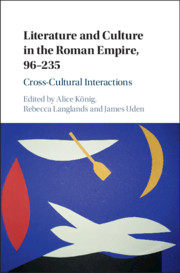Book contents
- Literature and Culture in the Roman Empire, 96–235
- Literature and Culture in the Roman Empire, 96–235
- Copyright page
- Contents
- Figures
- Contributors
- Preface
- Timeline
- Abbreviations
- Map
- Introduction
- Part I Refiguring Roman and Greek Interactions
- Part II Imperial Infrastructure: Documents and Monuments
- Chapter 7 Constructing a New Imperial Paradoxography
- Chapter 8 A Formation of a Christian Archive?
- Chapter 9 Keeping/Losing Records, Keeping/Losing Faith
- Chapter 10 Shaping Buildings into Stories
- Chapter 11 Architectural Criticism in the Roman World and the Limits of Literary Interaction
- Chapter 12 Dying for Justice
- Part III Cultural Translation and Transformation
- References
- Index
Chapter 10 - Shaping Buildings into Stories
Architectural Ekphrasis and the Epistle to the Ephesians in Roman Literary Culture
from Part II - Imperial Infrastructure: Documents and Monuments
Published online by Cambridge University Press: 28 April 2020
- Literature and Culture in the Roman Empire, 96–235
- Literature and Culture in the Roman Empire, 96–235
- Copyright page
- Contents
- Figures
- Contributors
- Preface
- Timeline
- Abbreviations
- Map
- Introduction
- Part I Refiguring Roman and Greek Interactions
- Part II Imperial Infrastructure: Documents and Monuments
- Chapter 7 Constructing a New Imperial Paradoxography
- Chapter 8 A Formation of a Christian Archive?
- Chapter 9 Keeping/Losing Records, Keeping/Losing Faith
- Chapter 10 Shaping Buildings into Stories
- Chapter 11 Architectural Criticism in the Roman World and the Limits of Literary Interaction
- Chapter 12 Dying for Justice
- Part III Cultural Translation and Transformation
- References
- Index
Summary
The New Testament Letter to the Ephesians hypostatizes the church’s qualities of unity into those of a bounded, ideal human body and building. As both a temple and a heavenly Colossus, the church has a vast architectural interior equal to divine grandeur reaching up to the same dominating heights of Christ’s own enthronement in heaven. This chapter examines how this architectural ekphrasis participated in aesthetics shared by many authors in Roman literary culture to turn buildings into stories in the final decades of the first century. In this period of cultural change, narratives about buildings shifted from an architecture of tyranny to encomiastic memorials of divine benefaction, unity and power associating grand architecture and the ideal human body. Attention to Roman architectural ekphrasis in Ephesians thus makes the mixed metaphor in Ephesians intelligible. It also offers a solution to an interpretative crux in the text previously considered insoluble. In these ways, therefore, this chapter rethinks the question of early Christian intertextuality as one of connectivity, examining the parallels as products of shared responses among discrete reading communities to Roman cityscapes.
Keywords
- Type
- Chapter
- Information
- Literature and Culture in the Roman Empire, 96–235Cross-Cultural Interactions, pp. 223 - 246Publisher: Cambridge University PressPrint publication year: 2020



